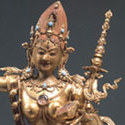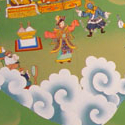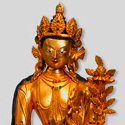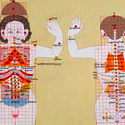|
|
| Show All 80 Results (Text Only) |
|
|
| Circle of Bliss: Buddhist Meditational Art |
|
| The Huntington Archive of Buddhist and Asian Art
|
Online presentation of a 2004 exhibition, with images of art, artifacts, ritual objects and practices, and related diagrams organized into 13 topics covering a range of issues related to enlightenment, meditation, and other Buddhist practice. In-depth explanatory text for all topics and images. Most of the artworks are from Tibet, Nepal, India, and China.
Go to Museum Resource: https://huntingtonarchive.org/Exhibitions/circleOfBliss.php | |
|
|
| Tibet Information Zone |
|
| The Newark Museum
|
Online version of the museum's Tibet Information Zone, "an interactive educational resource where individuals, families and school groups can gain valuable information on Tibetan life and culture, as well as learn about the Museum's extensive and world-renowned collection of sacred and secular Tibetan objects." With a virtual tour of the Tibet Buddhist Altar created by artist Phuntsok Dorje, along with images of a mural Dorje has created at the museum. Images from the mural ("depicting the vast snowy mountains, nomad tents, and rural villages of Tibet") illustrate a special section on Tibetan life, with overviews of nomadic life, Tibetan festivals, aristocratic life in old Lhasa, agriculture and farm life, and animals in Tibet.
Go to Museum Resource: https://www.newarkmuseum.org/tibet-information-zone | |
|
|
| Yamantaka Mandala |

|
| Minneapolis Institute of Arts
|
With an introduction to the mandala; a guide to the symbolism of the Minneapolis Institute's Yamantaka mandala, created by Tibetan monks from the Gyuto Tantric University; a step-by-step guide to the mandala's creation; plus technical details about the preservation of the mandala, a short video documentary of the mandala consecration ceremony, and background information about Tibet. See also Teacher's Guide.
Go to Museum Resource: http://archive.artsmia.org/art-of-asia/buddhism/yamantaka-mandala.cfm | |
|
|
| The Buddha Project |
|
| American Museum of Natural History
|
|
The Buddha Project contains a total of 1,038 images of objects drawn from the museum's Asia archives - an electronic database of images of objects from the American Museum of Natural History's Asia collection. The images represent a diverse spectrum of Buddhist iconography, differing by time period, country acquired, mode of representation of the Buddha, and object type. Four major events depicted in Buddha iconography - his conception, enlightenment, first sermon and death - are examples of images which may show the Buddha symbolically rather than anthropomorphically. The Buddha's enlightenment, for example, can be represented by the Bo Tree, his first sermon by a wheel, and his death by a burning funeral pyre without a visible body. Such images are often found at pilgrimage sites, where stone carvings were created which depicted either four or eight scenes of primary events from the Buddha's life including those described above. Such pilgrimage sites include monasteries, temples, and stupas - solid architectural structures believed to contain bodily relics of the Buddha and other holy persons. Since stupas, themselves, are often believed to be physical representations of the Buddha they, too, have been included into the Buddha Project. Catalog No. 70.0/4600 is one example of a stupa in the database.
While a good deal of attention has been paid to the importance and variety of symbolic representations of the Buddha, it is also significant, and potentially advantageous to researchers, to highlight the diverse and surprising variety of objects which were found to contain images of the Buddha in his human form which are also included into the Buddha Project. The variety of human forms of the Buddha found in the database, and also the variety of objects on which he is depicted, is demonstrative of the span of Asian countries and time periods from which these objects were collected.
Go to Museum Resource: https://anthro.amnh.org/buddha | |
|
|
|
| Mandala Sand Painting: Creating an Enlightened World |
|
| Asia Society
|
Over a 10-day period In September 2003 the Tibetan monks of Drepung Loseling Monastery constructed a sand mandala – a sacred cosmogram – "in commemoration of September 11 and as an offering of peace and healing to the people of New York City." This archive website includes images showing day-by-day construction of the mandala, as well as the original press release describing the event, an interview with Geshe Lobsang Tenzin, founder and director of Drepung Loseling Institute, and a Teacher's Guide to the Mandala.
Go to Museum Resource: http://sites.asiasociety.org/arts/mandala/index.html | |
|
|
| Tibetan Medical Paintings |
|
| American Museum of Natural History
|
"This rare, complete set of 79 Tibetan medical tangkas was painted by the Nepalese tangka artist Romio Shrestha and his Tibetan, Nepalese, and Bhutanese students in Kathmandu during seven years in the late 1980s and early 1990s. ... The medical tangkas form a unique document in the history of medicine. Firmly rooted in Buddhism, Tibetan medical practice drew on diverse earlier traditions, from India, ancient Greece, Persia, pre-Buddhist Tibet, and China, to form a synthesis visually documented in these paintings."
Go to Museum Resource: https://anthro.amnh.org/tangkas | |
|
|
|
| Show All 80 Results (Text Only) |








